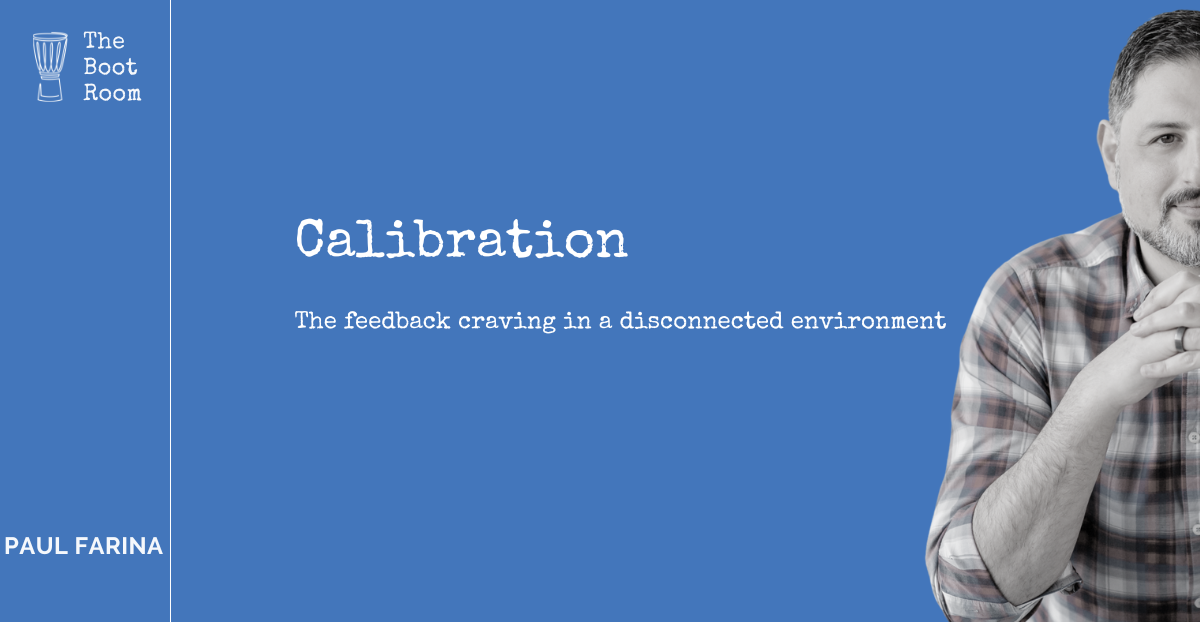Calibration
The feedback craving in a disconnected environment
Almost 100% of professional conversations include some form of feedback. High performers crave validation, low performers need guidance, and leaders consistently require perspectives and insights for good decision making. But, if we dig deeper, there is a finer level of feedback we rely on in our daily lives. The micro expressions and real time feedback we give/get when we enter a room, have a conversation, or attend a meeting occurs innately everyday. We constantly take in 100's of data points every moment telling us if we are striking the right tone, on the right track, or 'on the same page'. At a subconscious level we make tiny adjustments based on this feedback.
You may be naturally good at reading a room or not, but when we see out team and our customers everyday on a frequent basis we make these tiny adjustments constantly. With a heavy use of video and phone we still get a version of this, but we can all admit it is not the same. We are lacking a huge range of touch points we usually take for granted. We are starved of the feedback we use to calibrate our behaviour and form what Alex Pentland (MIT University Human Dynamics Lab) calls 'Belonging Cues'.
Knowing this can help us lead our teams with deliberate and purposeful tactics and can even become a competitive advantage. Pentland describes a few key behaviours for increasing a sense of safety and belonging in our team members. In dispersed professional environments we can utilise them to increase calibration. Here is Pentland's findings and my suggestions for a dispersed and isolated team:
close physical proximity, often in circles [regular video meetings - predictable, high interactivity, high transparency]
profuse amounts of eye contact [individual video calls with each other, not just with the leader]
physical touch (handshakes, fist bumps, hugs) [animate body language on video calls. Get physical. Use props]
lots of short, energetic exchanges (no long speeches) [short, succinct conversational style. Role model it and gently encourage it in others]
high levels of mixing; everyone talks to everyone [video and phone conferencing lends itself to structure. Loosen this up as much as you can. Let go of the reigns a little]
few interruptions [set the standard to have notifications turned off for 100% attention. Keep meetings short to enhance conformity to this]
lots of questions [more questions leave your mouth than statements. A good metric for leaders to keep track of]
intensive, active listening [mental note to self before getting on a video call. Prepare to raise your energy and to lean into the conversation]
humor, laughter [the biggest opportunity for most leaders - lighten up! Easier said than done when stakes are high. Being playful does not come at the cost of professionalism. I use the catchphrase 'human first and employee second'. It is contagious]
small, attentive courtesies (thank yous, opening doors etc) [prioritise manners before efficiency and performance. Ironically, you'll get better outcomes]
There are many more suggestions and ways to increase the feedback and connection we need for calibration and the resultant safety and belonging we crave. But, I hope the above provides one or two tools to play with. In an isolated world we can all do with supporting each other's calibration. In doing so, we'll more than likely improve our own!


